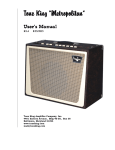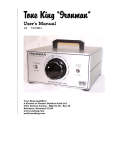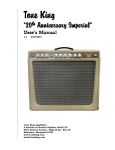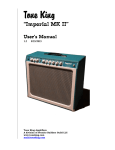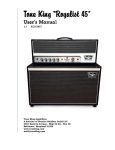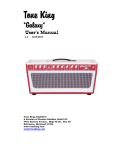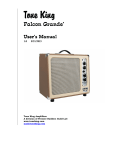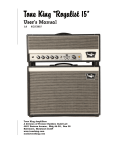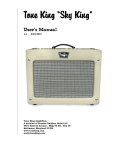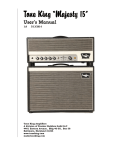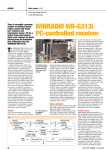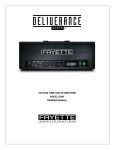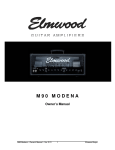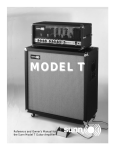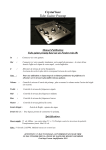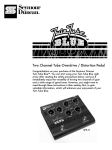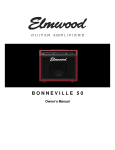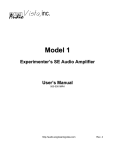Download the Falcon User Manual
Transcript
Tone King “Falcon” User’s Manual 1.2 8/25/2015 Tone King Amplifiers A division of Premier Builders Guild LLC 4401 Eastern Avenue, Bldg 45-2A, Box 38 Baltimore, Maryland 21224 www.toneking.com [email protected] Note from the Builder Thank you for choosing Tone King’s “Falcon” guitar amplifier. The Falcon is a fresh new design, quite a bit different than its predecessors in the Tone King line. The Falcon is inspired by the sound of smaller size, funky old vintage amps – tweed champs, Supros, old field coil Gibson amps, etc. The goal with this design was to get the loose, raw sound of that sort of amp – the clank and the grind - but without the raspiness. Instead, I wanted each note to have a sweet candy coating, floating in a river of rich maple syrup. There were two key factors to achieving this. First, I developed a cabinet design that is surprisingly warm, full, and resonant for its size. This required a certain type of construction, and resulted in the chassis being mounted to the side of the cabinet, which also lends the Falcon its own unique look. Next, I employed an unusual output stage configuration in which a pair of 6V6 tubes is operated in Ultralinear mode, and cathode biased. In Ultralinear mode, the output tubes act more like triodes than pentodes, which tends to favor production of lower order harmonics, resulting in less raspiness, more depth, and a sweetly rounded quality. At 12W, the Falcon was too loud to be used in a home environment, so I added a limited version of our Ironman attenuator with 6 levels of attenuation, to bring the volume down by 35db, all the way to a genuine bedroom volume. In the end, the Falcon turned out to have a wonderful variety of genuine old-school tones, and be an absolute blast to play. I thank you for your purchase of the Falcon, and I hope you enjoy playing it as much as I do. Best Regards, Mark Bartel Tone King Amplifiers, a division of Premier Builders Guild LLC 1 Safety Instructions (Important !) 1. Please read these instructions, and keep them for reference. 2. Please follow all instructions described here. 3. Do not use this apparatus near water. 4. Clean only with a dry cloth. 5. Do not block any ventilation openings. 6. Do not operate near any heat sources such as radiators or heat registers. 7. Protect the power cord from being walked on or pinched, particularly at the plugs and at the point where they exit from the apparatus. 8. Only use attachments/accessories specified by the manufacturer. 9. Unplug this apparatus during lightning storms or when unused for long periods of time. 10. Refer all servicing to qualified service personnel. Servicing is required when the apparatus has been damaged in any way. For example, if the power supply cord or plug is damaged, liquid has been spilled or objects have fallen into the apparatus, the apparatus has been exposed to rain or moisture, does not operate normally, or has been dropped. 11. CAUTION: To disconnect the unit completely from the MAINS, unplug the unit. Turning the power switch off does not disconnect the unit completely from the MAINS. 2 Contents 1. Front Panel Controls 4 HI and LO Inputs 4 Volume and Tone Controls 4 Voicing Switch 4 2. Dialing In Your Sound 5 Rhythm Voicing 5 Tweed Voicing 5 Lead Voicing 6 3. Back Panel Controls 7 AC Power 7 Fuse 7 Power Switch, Standby Switch 7 Speaker Jack 7 Attenuation Controls 8 Notes on Using the Attenuator 8 4. Tube Installation and Replacement 9 Choice of Tube Types and Brands 9 Important Note Regarding V2 9 12AX7 Tubes 10 6V6 Tubes 10 Alternate Tube Choices 10 Installing Tubes 11 Replacing Output Tubes 11 Tube Quality 11 5. Warranty 12 3 1. Front Panel Controls HI and LO Inputs Two input jacks are provided, each with a different level of gain. The HI input has a higher level of gain than the LO input. You may find it useful to use the HI input with guitars that have single coil or otherwise lower output pickups, and the LO input for guitars with humbuckers or high output single coil pickups. Regardless, these guidelines are not intended as set rules. There are many cases where they would be used otherwise. Volume & Tone Controls The first stage of the Falcon’s preamplifier is very similar to a vintage tweed deluxe amplifier. Because of this, the volume and tone controls are highly interactive. This means that changing the volume control will have some effect on the tone (balance of treble-to-midrange-to-bass), and changing the tone control will have some effect on the volume of the amp. Although this seems like an inconvenient setup, it actually provides a much wider range of available tones. If you are not familiar with using interactive Volume and Tone controls, it may take some experimenting to become familiar with how best to use it. Voicing Control The Voicing control allows you to select between three distinct “voicings”, each with its own unique level of gain and tonal characteristics. Note that the ability to switch between voicings does not mean that the Falcon is a three channel amplifier – it is a single channel design, with a variety of tonal options provided by the Voicing control. 4 2. Dialing In Your Sound The Falcon is capable of a surprisingly wide range of tones, and the Voicing knob is the key to accessing the Falcon’s tonal palette. Each selection of the voicing knob is intended for a specific use, and it’s important to know the intention of each voicing in order to get the most out of the Falcon. “Rhythm” Voicing The "rhythm" voicing is intended to give you more or less a blackface Fender sound. In order to get this kind of sound, however, you need to set the volume and tone controls a certain way. This setting is a good starting point: Input Volume Tone Voicing LO 3 3 Rhythm “Tweed” Voicing The "tweed" voicing gives you roughly the same preamp voicing as a vintage tweed deluxe. There are two main uses for this channel. The first is a fat clean sound with a nice rounded top end, which you can find with the following settings: Input Volume Tone Voicing LO 3 8 Tweed The second use for this channel is a thick tweed style overdrive, which can be had at the following settings: Input Volume Tone Voicing HI 9 7 Tweed 5 “Lead” Voicing The "lead" voicing is intended exclusively for overdriven and distorted tones. It is not intended for clean tones. This is why it has more gain than the other settings, and why it begins to break up at low volume control settings. It may take some experimenting to find the sweet spots that give you the best tones with a particular guitar. Here are a few sample settings to get you started. First a nice chunky grind – Input Volume Tone Voicing HI 3 6 Lead Input Volume Tone Voicing HI 7 7 Lead Next, a more saturated distortion: The Falcon gets almost all of its overdrive and distortion from the output tubes (6V6s). When you are pushing it hard in the lead setting, it reaches maximum output early on, and simply becomes more saturated as you turn up the volume control. This is how any non-master design works - tweed amps, etc. The Falcon is designed for rootsy, oldschool vintage tone, and this kind of tone is all about power tubes being driven hard and generating their own kind of distortion and compression. 6 3. Back Panel Controls AC Power Always use a grounded AC cord, and make sure that a proper ground connection is supplied to the amp. Never attempt to lift or defeat the ground connection to the amp. Fuse A standard 2A slo-blo fuse (style 3AG) should be used. Power Switch, Standby Switch When powering up the amp, you should start with the Power switch OFF, and the Standby switch in the "STANDBY" position. First, turn on the Power switch. This will apply power only to the tube filaments only. After turning on the Power switch, allow the tubes to warm up for about 1 minute, then toggle the Standby switch to the “OPERATE” position. The power-down sequence is not as important as the power-up sequence. When turning the amp off, you may turn Power off before Standby, or turn Standby off before Power, or turn them both off at the same time. Speaker Jack The speaker jack is located on the side of the chassis, and is not labeled. It is a standard ¼” mono jack. The output impedance of the amplifier is 8 Ohms. If you wish to use the Falcon with an extension cabinet, it’s best to use an 8-ohm cabinet. You can connect it with a standard ¼” mono speaker cable by pulling out the plug from the internal speaker, and plugging the cable into the speaker jack. 7 Attenuation Control The Falcon contains a built-in Ironman precision attenuator. The attenuator allows you to reduce the volume level of the amplifier while allowing its output tubes to operate at full output power, for natural power tube overdrive and distortion. This attenuator uses transformer coupling and a precision tuned reactive load to best preserve the natural tone and feel of the amp, even at very low volume. This is the same general approach used in the highly regarded Ironman standalone attenuator. There are many different approaches that can be used to generate overdriven and distorted tones as a low volume. For example, master volume circuits, or a power reduction scheme such as London Power Scaling have both been used successfully on various amp models of other brands. However, for the more vintage sounding tones that the Falcon is designed to achieve, a good quality attenuator such as the built-in Ironman is the best way to preserve tone and feel at very low volume, because it allows the output stage to operate the same way at any level of attenuation. The attenuation control determines the amount of power sent to the speaker, but does not affect the operation of the output stage of the amplifier itself. The attenuator absorbs and dissipates any excess power generated by the output tubes that is not sent to the speaker. The attenuator is internally connected between the amplifier output and the speaker jack – the same way an external attenuator would be connected. However, the input of the attenuator is not accessible, so you cannot use the built-in Ironman attenuator to attenuate the output of some other amplifier. Notes on using the attenuator In the 0db position, the attenuator is completely bypassed, and the speaker is connected directly to the output transformer secondary, with no additional circuitry touching the signal path. Although the Ironman attenuator does an excellent job of reducing output power without changing the tone of the amp’s circuitry, there are other variables in play at lower volume which do result in some apparent tone change. Here are a few factors that you should be aware of Speaker breakup and compression is a big part of the tone and feel of the amp when played at high volume. At low power settings, the speaker responds differently, and does not break up and compress as it does at high power. The ear’s natural response curve varies at different volume levels, which changes the way you perceive sounds at different volume levels. Quieter sounds tend to give the impression of having less bass content. At lower volume, there is a tendency to hit the guitar strings harder and play more aggressively than you would if the amp were tuned up very loud. It may take some time to get used to maintaining your playing style at reduced volume. 8 4. Tube Installation Installation and Replacement Choice of Tube Types I currently recommend the following tube types: No. Function Type/Brand V1 1st & 2nd Gain Stages TAD 12AX7A-C V2 2nd Stage C.F. + 3rd Stage Sovtek 12AX7WA V3 Phase Inverter TAD 12AX7A-C V4,V5 Output Tubes TAD 6V6 The tube brands shown above are my own preferences. You may want to use other brands, to tailor the sound to your own tastes. 6V6 WARNING ! The following brands are NOT recommended, as we’ve experienced a high rate of redplating and short circuit faults with these: • • Tung Sol 6V6GT EH 6V6GT manufactured after December 2014 We had been recommending EH brand 6V6s for years. These were great tubes, but some time around December 2014, the manufacturer changed the design, and they now appear to share the same construction as the Tung Sol 6V6. After the design change, we noticed the same reliability problems as the Tung Sol 6V6, so we no longer recommend using the EH 6V6 of current manufacture. 6V6 Tube Choices: Choices I prefer the TAD 6V6 for its warmth, smooth compression, and balanced top end. The JJ brand 6V6 is another acceptable choice. The JJ 6V6 has a bigger, fatter sound than the TAD, but is a bit less lively sounding, and has a more muted top end. It sounds a bit more like a 6L6 than a 6V6. 9 Important Note Regarding Tube V2 V2 is configured as a cathode follower. It’s not important to understand what this means, but it is important to know that some 12AX7 brands available today will fail when used as a cathode follower. We have noted failures with the Tung Sol 12AX7, and advise against using the EH 12AX7 and Sovtek 12AX7LPS as well. One brands that has proven reliable for the V2 tube is the Sovtek 12AX7WA. This restriction only pertains to the V2 tube – not V1 or V3. Here are a few notes on the various brands available today: 12AX7 Tubes: Tubes Both the TAD 12AX7A-C, and the Tung Sol 12AX7A are a great match for the Falcon. Both have a nice balance of detail and warmth, with the Tung Sol having perhaps a bit more transparency in the top end, and the TAD having a bit less glassiness but still a nice presence in the upper mids. EH 12AX7s are very similar to Tung Sol 12AX7s – both are very quiet with very low microphonics and are a bit on the bright side, with an extended top end. Tung Sols seem a bit warmer than EHs. The Svetlana 12AX7, a short-plate tube, has nearly the clarity of the 12AX7EH, and slightly more bottom end, but is a bit congested in the midrange. Years ago, I had selected this brand as the brand of choice for the Meteor/II amp, but later changed to a combination of the 12AX7EH and the 12AX7LPS. Sovtek 12AX7LPS – this long-plate 12AX7 has a big, warm sound that comes close to a good NOS long-plate 12AX7. However, this tube can tend to be microphonic. Alternate Tube Choices You May Want to Try Reducing Gain: If you find the preamp too gainy, and you find that you’re setting the volume controls down quite low to get sufficient clean headroom, you may want to try swapping in a 12AU7 in the V1 position. 10 Installing Tubes When installing tubes, you may find it helpful to lay the amp on its side on a table, and shine a light directly into the back of the amp, to aid in locating the position of each tube. Tubes must be installed in the correct orientation. The smaller, all-glass tubes have a blank space in the ring of pins which must line up with the blank space in the ring of tube pins in the tube socket, located on the chassis. The larger, bakelite-base tubes have a small cylinder with an indexing key in the center of the ring of tube pins, and this indexing key must match up with the corresponding slot in the socket on the chassis. Replacing Output Tubes The output stage of the Falcon is fully cathode biased, and no bias adjustment is necessary when changing output tubes. The design of the Falcon’s output stage allows a fair amount of margin for variation in tube characteristics, so any known brand of 6V6 can be installed, and will work properly and be appropriately self-biased. Tube Quality Currently manufactured tubes are built in China, Russia, or the Czech Republic, and are not built to the same quality standards as tubes manufactures by the U.S. manufacturers in the “glory days” of tube manufacturing. We musicians choose to use to vacuum tubes because of their tone, but we need to accept that the tubes available to us these days can be imperfect devices, and are most certainly the least reliable component in the entire amplifier. It would seem that the obvious solution would be to use new-old-stock tubes that were made back in the “glory days”, when tubes were properly made. However, I’ve lately been finding that much of the available stocks of such “new old stock” tubes are either gassy, noisy, or unreliable – I do believe that we’ve reached the bottom of the barrel of NOS tubes. Tube problems generally reveal themselves as a crackling noise which can occur continuously, sporadically, in response to mechanical vibration, or in response to your playing (e.g. a crackling or other type of noise which occurs only when you hit a note). We subject all tubes to a thorough burn-in and test procedure to ensure that they are fully up to spec and operating perfectly. However, you must be aware that the majority of tube failures occur early in their life, and may come about as a result of the jostling and jarring that an amp can receive in shipping. In spite of the exhaustive testing we perform at the shop, early-life tube problems cannot always be found in such testing. The first two months or so are the most tenuous period for any set of tubes. Most manufacturing defects will be revealed in the first two months of their life, but many are not detectable in initial testing, even after a burn-in period. If you notice any noises, cracking, or any other odd behavior of your amplifier in this period, note that it is most likely to be the result of a defective tube, and should be debugged as such. 11 Premier Builders Guild LLC Limited Warranty Premier Builders Guild LLC 201 S. Highland Avenue, Suite 204 Pittsburgh, PA 15206 This warranty gives you specific legal rights; you may also have other rights which vary from state to state. There are no express warranties except those listed below. Length of Warranty This warranty shall remain in effect for five years from the date of sale of the product as shown on the original bill of sale. What is Covered This warranty covers all defects in material and workmanship in this product, with the following exceptions: 1. Damage or deterioration of the cabinet, or any other cosmetic damage which occurs after delivery is not covered by this warranty. 2. Damage after initial delivery resulting from accident, unreasonable use, or neglect, is not covered by this warranty. 3. Damage resulting from the performance of repairs by someone other than the Tone King Amplifier Company is not covered by this warranty. 4. Damage occurring during shipment or delivery of this product to the Tone King Amplifier Company after initial delivery of the product is not covered by this warranty. 5. Vacuum tubes are considered a user-replaceable item, as they are expected to wear out and require replacement over a reasonable period of time. Tubes are warranted to be serviceable for a period of 90 days from the date of sale. 6. The speaker(s) in this amplifier has(have) been selected for use only with this amplifier. If the speaker(s) of this amplifier is(are) connected to an amplifier other than the intended amplifier, any warranty of this speaker shall be deemed void. What We Will Pay For The Tone King Amplifier Company will pay for all labor and material expenses to fix or replace all items covered under this warranty. The customer will pay shipping charges to return the product to the Tone King Amplifier Company. If the necessary repairs are covered under this warranty, the Tone King Amplifier Company will pay any shipping charges required to return the product to the customer. Limitation of Implied Warranties All express or implied warranties of merchantability and fitness for a particular purpose are limited in duration to the length of this warranty, unless otherwise provided by state law. Exclusion of Certain Damages The Tone King Amplifier Company’s liability is limited to the repair or replacement, at our option, of any defective product, and shall in no event include incidental or consequential damages of any kind. Some states do not allow limitations on the length of an implied warranty and/or do not allow the exclusion of incidental or consequential damages, so the above limitations and exclusions may not apply to you. Obtaining Warranty Service If your unit requires service, it should be returned to the Tone King Amplifier Company at the address listed above. Before returning the unit, you must contact the Tone King Amplifier Company and obtain return authorization. 12 CE Declaration 13














